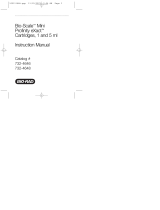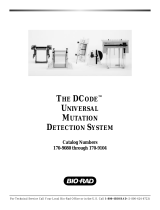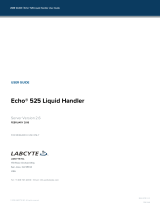Page is loading ...

VitroEase™ Buer Screening Kit
Doc. Part No. 2162742 Pub. No. MAN0019733 Rev. A.0
WARNING! Read the Safety Data Sheets (SDSs) and follow the handling instructions. Wear appropriate protective eyewear,
clothing, and gloves. Safety Data Sheets (SDSs) are available from thermofisher.com/support.
Product description
The Thermo Scientific™ VitroEase™ Buer Screening Kit enables ecient optimization of cryo-EM samples for single particle analysis.
Sample screening evaluates protein behavior in various buers with and without additives with the end goal of identifying the optimal
conditions where the protein is structurally intact, randomly oriented, and equally distributed in ice. The kit contains a broad range
of pre-formulated buers and detergents (10X concentrations) that have been provided with color-coded caps that correlate with the
color-coded screening strategy. The comprehensive sample screening strategy uses two rounds of screening and 24 conditions that can
be screened in two working days on the microscope with the Autoloader. A condensed strategy is also provided using 8 conditions and
taking one working day to screen in the microscope with the Autoloader.
Contents and storage
Product Cat. No. Kit Contents
(Sucient for up to 400 grids preparation) Volume Storage
VitroEase™
Buer
Screening
Kit
A49856
Buer 1 (10X): C2H3NaO2 (0.5 M), NaCl (1.5 M); pH 3.6 400 µL
Store at –20°C.
Thaw reagents
on ice before
use. Product is
stable through
multiple
freeze/thaw
cycles.
Buer 2 (10X): C2H3NaO2 (0.5 M), KCl (3 M); pH 3.6 400 µL
Buer 3 (10X): MES (0.5 M), NaCl (1.5 M); pH 5.5 400 µL
Buer 4 (10X): MES (0.5 M), KCl (3 M); pH 5.5 400 µL
Buer 5 (10X): Tris-HCl (0.5 M), Mg (CH2COO)2 (0.1 M), NaCl (1.5 M); pH 7.2 400 µL
Buer 6 (10X): Tris-HCl (0.5 M), MgCl2 (0.1 M), CH3CO2K (1.5 M); pH 7.2 400 µL
Buer 7 (10X): Tris-HCl (0.5 M), Mg(CH3COO)2 (0.1 M), KCl (3 M); pH 7.2 400 µL
Buer 8 (10X): HEPES (0.5 M), NaCl (1.5 M); pH 7.4 400 µL
Buer 9 (10X): HEPES (0.5 M), KCl (3 M); pH 7.4 400 µL
Buer 10 (10X): HEPES (0.5 M), Mg(CH3COO)2 (50 mM), CH3CO2K (1.5 M); pH 7.4 400 µL
Buer 11 (10X): HEPES (0.5 M), MgCl2 (50 mM), CaCl2 (50 mM), NaCl (1.5 M); pH 7.4 400 µL
Buer 12 (10X): PBS (1.37 M NaCl, 270 mM KCl, 43 mM Na2HPO); pH 7.4 400 µL
Buer 13 (10X): Bicine buer (0.5 M), NaCl (1.5 M); pH 8.5 400 µL
Buer 14 (10X): CAPSO (0.5 M), KCl (3 M); pH 8.9 400 µL
Detergent A (10X): CTAB (0.3%) 100 µL
Detergent B (10X): CHAPS (4.9%) 100 µL
Detergent C (10X): β-OG (2.7%) 100 µL
Detergent D (10X): Tween™ 20 (0.1%) 100 µL
Detergent E (10X): DM (1%) 100 µL
Detergent F (10X): FOM (0.7%) 100 µL
USER GUIDE
For Research Use Only. Not for use in diagnostic procedures.

Procedure summary
Figure 1 Workflow of sample optimization using the VitroEase™ Buer Screening Kit.
Materials required but not supplied
• Protein sample (concentration ~1–10 mg/mL)
• P10 adjustable pipettes and tips
• Sample preparation reaction tubes (Cat. No. 4358297)
•(Optional) Mini desalting column (Cat. No. 89878)
•(Optional) Protein concentrator (Cat. No. 88535)
• Vitrobot Mark IV filter paper
•Vitrification tools (e.g., Vitrobot™ Mark IV System) (http://www.thermofisher.com/nl/en/home/electron-microscopy/products/
sample-preparation-equipment-em/vitrobot-system.html)
• EM grid tweezer
• Cryo-EM grids (e.g., Quantifoil™ R 1.2/1.3 on 200 or 300 mesh)
• Auto grids and C-clip rings
Additional information
• Optimize vitrification settings independent of sample optimization.
• Use of detergents may aect protein distribution as well as the number of particles per hole.
• Sample optimization conditions are strongly dependent on the protein.
• Remove sugar, glycerol, and high salt concentration (>500 mM) from protein solution prior to using the optimization kit.
• Applied sample volume for vitrification is recommended for use with the Vitrobot™ Mark IV System. Dierent vitrification instruments
may require dierent volumes and/or concentrations.
• The recommended screening strategy is based on using a Thermo Fisher Scientific Autoloader-based TEM-microscope: Krios™,
Glacios™, or Talos™ Arctica™.
• Detergents and dierent pH can aect the structure and function of protein of interest. It is recommended that once an optimal
condition for cryo-EM is found, a biochemical assay is used to verify the protein function.
• Grid type selection for cryo-EM sample preparation has to be verified prior to using screening strategy. It is not recommended to
change grid type for dierent conditions during buer optimization.
• Adding 10X buers and detergents will dilute the protein samples, but the small volumes used should not significantly aect the
cryo-EM applications .
2VitroEase™ Buer Screening Kit User Guide

Recommended comprehensive screening strategy
Table 1 Recommended comprehensive screening strategy.
First Screening Round Second Screening Round
1 Protein with lower concentration (1 mg/mL) in the purification buer
1Buer (best condition from Round 1) + 0.5 µL × CMC CTAB
2Protein with higher concentration (up to 10 mg/mL) in the purification
buer 2Buer (best condition from Round 1) + 0.75 µL × CMC
CTAB
3 Buer 1 or Buer 2, pH 3.6 3 Buer (best condition from Round 1) + 0.5 µL × CMC
CHAPS
4 Buer 3 or Buer 4, pH 5.5 4 Buer (best condition from Round 1) + 0.75 µL × CMC
CHAPS
5 Buer 6, pH 7.2 5 Buer (best condition from Round 1) + 0.25 µL × CMC FOM
6 Buer 7, pH 7.2 6 Buer (best condition from Round 1) + 0.5 µL × CMC FOM
7 Buer 10 or Buer 11, pH 7.4 7 Buer (best condition from Round 1) + 0.25 µL × CMC
Tween-20™
8 Buer 13, pH 8.5 8 Buer (best condition from Round 1) + 0.5 µL × CMC
Tween-20™
9 Buer 14, pH 8.9 9 Buer (best condition from Round 1) + 0.25 µL × CMC β-OG
10
Buer 5, pH 7.2
+ 0.1 µL × CMC β-OG
or 0.75 µL × CMC DM
10 Buer (best condition from Round 1) + 0.75 µL × CMC β-OG
11
Buer 8, pH 7.4
+ 0.75 µL × CMC Tween-20™
or 0.75 µL × CMC FOM
11 Buer (best condition from Round 1) + 0.25 µL × CMC DM
12
Buer 9, pH 7.4
+ 0.1 µL × CMC CHAPS
or 0.1 µL × CMC CTAB
12 Buer (best condition from Round 1) + 0.5 µL × CMC DM
Round 1: Protein concentration optimization (2 grid conditions)
Note: Higher protein concentrations may improve the protein stability and distribution on the cryo-EM grid. Starting protein concentration
for optimization of cryo-EM sample preparation is ~3–10 times higher than the concentration used for a negative stain grid.
1. Prepare one grid with lower protein concentration (e.g., 0.5–2 mg/mL) to separate particles for better recognition of the particles.
2. Prepare a second grid at the highest available protein concentration up to 10 mg/mL to identify whether the protein is amenable to
close packing (sometimes referred to as carpets or monolayers).
3. Mix the freshly made solution well and apply 3 µL of mixture to a freshly glow discharged EM grid and start the plunge freezing
process.
VitroEase™ Buer Screening Kit User Guide 3

Round 1: Buer and pH selection (7 grid conditions)
Kit buers are provided with pH ranges between 3.6 and 8.9, pre-mixed with various salts and divalent cations. The conditions are
color-coded in the table and match the tube cap colors for ease-of-use.
Use Buers 1-14 based on choices using the Screening table.
1. Prepare one grid with the buer condition that is most similar to the original purification buer.
2. Prepare additional six grids to test ideal pH and salt concentrations as shown in first screening round. Buers have been provided at
pH values with two salt conditions. There are also buers 6, 10 and 11 in neutral pH to test protein behavior in ice with addition of
cationic ions.
3. Thoroughly mix the freshly made solution, apply 3 µL of mixture to a freshly glow-discharged EM grid, and start the plunge-freezing
process.
Example: Select one condition with a low pH value such as Buer 3 (50 mM MES, 150 mM NaCl, pH 5.5). Select the buer with the
same pH with varying salt concentrations to test the requirements for ionic strength and protein stability such as Buer 4, (50 mM
MES, 300 mM KCl, pH 5.5).
Mix buers and additives just before vitrification. Do not incubate the solution for excessive time. Do not mix dierent buers from the kit
for one sample preparation.
Round 1: Detergent screening (3 grids)
The purpose of using detergent in the first screening round is to determine the eect detergent charge, concentration, and CMC on
protein behavior in ice.
1. Prepare mixture of Protein Solution with 10X Buer and Detergent as indicated in screening strategy Round 1.
2. Thoroughly mix the freshly made solution, apply 3 µL of mixture to a freshly glow-discharged EM grid, and start the plunge-freezing
process.
Possible outcomes with detergent screening in Round 1
• If there was no improvement in particle orientation after adding detergents, the concentration of detergent should be increased up to
its CMC value in the second screening round.
• If the number of particles decreased significantly after adding a detergent, the protein concentration needs to be increased.
• If there was visible improvement, then the first screening result will direct the user to determine the buer and detergent selection for
the second screening round.
• If there was no visible improvement in the first screening round, then the sample stability and integrity should be improved in the
upstream protein purification.
Round 2: Detergent optimization (12 grids)
Note: Use the optimal Buer and Protein Concentration determined in the Round 1 screening.
1. Prepare the mixture of Protein Solution with 10X Buer, as indicated in the screening strategy for Round 2.
2. Thoroughly mix the freshly made solution, apply 3 µL of mixture to a freshly glow-discharged EM grid, and start the plunge-freezing
process.
Note: If the number of particles decreased after adding a detergent, the protein concentration needs to be increased.
4VitroEase™ Buer Screening Kit User Guide

Limited screening round (8 grids)
The table below provides guidelines for screening a limited number of conditions for protein optimization on a grid.
Note: The first 4 conditions can be prepared in duplicate.
Table 2 Limited screening strategy.
Limited Screening Strategy
1Low pH buer
Buer 3, pH 5.5 1 µL Buer 3 + 9 µL protein solution
2Neutral pH, High salt
Buer 7, pH 7.2 1 µL Buer 7 + 9 µL protein solution
3 Neutral pH 7.4 buer + 0.5 µL× CMC CTAB 1 µL Buer 11 + 9 µL protein solution
4Neutral pH 7.4 buer + 0.5 µL × CMC
CHAPS 1 µL neutral (pH 7.4) buer + 9 µL protein solution + 0.5 µL CHAPS
5Neutral pH + Cationic ions
Buer 11, pH 7.2 1 µL neutral (pH 7.4) buer + 9 µL protein solution + 0.5 µL CTAB
6 Neutral pH 7.4 + 0.5 µL × CMC β-OG 1 µL neutral (pH 7.4) buer + 9 µL protein solution + 0.5 µL β-OG
7 Neutral pH 7.4 + 0.5 µL × CMC FOM 1 µL neutral (pH 7.4) buer + 9 µL protein solution + 0.5 µL FOM
8 Neutral pH 7.4 + 0.5 µL × CMC DM 1 µL neutral (pH 7.4) buer + 9 µL protein solution + 0.5 µL DM
Recommended conditions in limited screening round
• Prepare mixture of Protein Solution (determined in protein concentration optimization), 10X Buer, and Detergent indicated in the
table above.
• Thoroughly mix the freshly made solution, apply 3 µL of mixture to a freshly glow-discharged EM grid, and start the plunge-freezing
process.
Note: If the number of particles decreased after adding a detergent, the protein concentration needs to be increased.
Table 3 Detergent CMC guidelines for additional optimization.
Detergents Class/Head
Group CMC Stock
Concentration 0.1 × CMC 0.25 × CMC 0.5 × CMC 0.75 × CMC
CTAB (Hexadecyl-trimethyl-
ammonium bromide Cationic 0.03% 0.3% 0.1 µL 0.25 µL 0.5 µL 0.75 µL
CHAPS (3-[(3-
Cholamidopropyl)dimethylammon
io]-1-propanesulfonate)
Zwitterionic 0.49% 5% 0.15 µL 0.24 µL 0.49 µL 0.74 µL
β-OG (Octyl-β-D-Maltoside) Non-ionic 0.27% 2.7% 0.1 µL 0.25 µL 0.5 µL 0.75 µL
Tween-20™ (Polysorbate 20) Non-ionic 0.01% 0.1% 0.1 µL 0.25 µL 0.5 µL 0.75 µL
DM (n-Decyl-β-D-Maltoside) Non-ionic 0.09% 1% 0.1 µL 0.25 µL 0.5 µL 0.75 µL
FOM (Fluorinated Octyl Maltoside) Non-ionic 0.07% 0.7% 0.1 µL 0.25 µL 0.5 µL 0.75 µL
VitroEase™ Buer Screening Kit User Guide 5

Troubleshooting
Observation Possible cause Recommended action
Detergent or buer solution volume,
color, or viscosity changed.
Wrong product storage condition
was used.
Store at recommended condition.
Precipitate formed due to slow
freeze/thaw cycle.
Heat back into solution for 5–10 minutes in a 37°C water bath.
Perform a quick freeze/thaw cycle for 5 minutes in a 37°C water bath.
Prepared cryo-EM sample is not
easy to pipet for loading on the EM
grid.
High viscosity formed due to wrong
dilution factor being used for the
cryo-EM sample preparation.
Make a 1:10 dilution of Kit buer (10X):Protein solution.
Vitreous ice is too thick or thin. Non-optimized vitrification settings
were used.
Adjust blotting time and force.
Sample is falling apart in vitreous
ice.
Unsuitable vitrification buer was
used.
Test various buers with dierent pH, salt, and detergent.
Upstream sample optimization was
required.
Optimize protein purification steps and verify protein stability by
biochemical assays prior to vitrification.
Not all protein orientations are
present.
Particle absorbance occurred at the
air to water interface. (Compromised
by the tendency of proteins to align
in non-random ways.)
Use various buers with dierent pH, salt, and additive.
Use the recommended detergent screening in the second screening
round.
Low image contrast/low signal-to-
noise ratio.
Incompatible compound was used
in the cryo-EM procedure.
Remove a compound from the protein solution (e.g., by using Zeba™
columns or dialysis membranes).
Decrease in particle number after
detergent addition.
Suboptimal protein to detergent
concentration was used.
Increase protein concentration in the presence of detergent.
Decrease the detergent concentration.
Limited product warranty
Life Technologies Corporation and/or its aliate(s) warrant their products as set forth in the Life Technologies' General Terms and
Conditions of Sale at www.thermofisher.com/us/en/home/global/terms-and-conditions.html. If you have any questions, please
contact Life Technologies at www.thermofisher.com/support.
Life Technologies Corporation | J.H. Oortweg 21 | 2333 CH Leiden | The Netherlands
For descriptions of symbols on product labels or product documents, go to thermofisher.com/symbols-definition.
The information in this guide is subject to change without notice.
DISCLAIMER: TO THE EXTENT ALLOWED BY LAW, THERMO FISHER SCIENTIFIC INC. AND/OR ITS AFFILIATE(S) WILL NOT BE LIABLE FOR SPECIAL, INCIDENTAL, INDIRECT,
PUNITIVE, MULTIPLE, OR CONSEQUENTIAL DAMAGES IN CONNECTION WITH OR ARISING FROM THIS DOCUMENT, INCLUDING YOUR USE OF IT.
Revision history: Pub. No. MAN0019733
Revision Date Description
A.0 16 April 2021 New document.
Important Licensing Information: These products may be covered by one or more Limited Use Label Licenses. By use of these products, you accept the terms and conditions of all
applicable Limited Use Label Licenses.
©2021 Thermo Fisher Scientific Inc. All rights reserved. All trademarks are the property of Thermo Fisher Scientific and its subsidiaries unless otherwise specified.
thermofisher.com/support | thermofisher.com/askaquestion
thermofisher.com
16 April 2021
/












